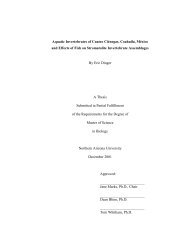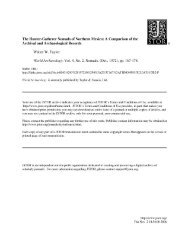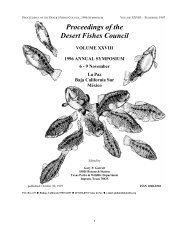Proceedings of the Desert Fishes Council 2000
Proceedings of the Desert Fishes Council 2000
Proceedings of the Desert Fishes Council 2000
You also want an ePaper? Increase the reach of your titles
YUMPU automatically turns print PDFs into web optimized ePapers that Google loves.
PROCEEDINGS OF THE DESERT FISHES COUNCIL - VOLUME XXX1I (<strong>2000</strong> SYMPOSIUM) – PUBLISHED NOVEMBER 13, 2001<br />
Butler, VL 1 ; Delacorte, MG 2<br />
(1-Portland State University; 2-California State University, Sacramento)<br />
<strong>Desert</strong> fishes <strong>of</strong> <strong>the</strong> past: archaeological fish remains from Owens Valley, California<br />
ABSTRACT<br />
Excavation <strong>of</strong> multiple archaeological sites in Owens Valley, California, has provided a substantial<br />
assemblage <strong>of</strong> fish remains spanning much <strong>of</strong> <strong>the</strong> last 8000 years. Striking changes in taxonomic representation<br />
and body size are indicated. Large-bodied Catostomus fumeiventris (Owens sucker) dominates early sites that<br />
date before 4500 years ago; Gila bicolor (tui chub) and smaller Catostomus predominate in later sites that date<br />
to <strong>the</strong> last 500 years. Two main factors, environmental change and cultural use patterns, may account for <strong>the</strong>se<br />
trends. The environmental explanation suggests that changes in extent and stability <strong>of</strong> aquatic habitat favored<br />
different fish taxa given differences in life history strategies. The cultural explanation holds that <strong>the</strong>re was a<br />
wider expansion in resource use, leading to scheduling conflicts and shifts in fish use. These explanations are<br />
examined along with <strong>the</strong> difficulty <strong>of</strong> distinguishing environmental from cultural factors in accounting for<br />
change in <strong>the</strong> archaeological record.<br />
RESUMEN<br />
Peces del desierto del pasado: restos arqueológicos ícticos del Valle Owens, California<br />
La excavación de sitios arqueológicos del Valle Owens ha aportado un importante conjunto de restos de<br />
peces que abarcan la mayor parte de los últimos 8,000 años. Se aprecian impresionantes cambios de la<br />
representación taxonómica y tamaño corporal. Individuos de cuerpo grande de Catostomus fumeiventris<br />
(matalote del Owens) dominan en los sitios tempranos de hace más de 4,500 años; Gila bicolor (carpa tui) e<br />
individuos de cuerpo más pequeño de Catostomus predominan en sitios más recientes que abarcan los últimos<br />
500 años. Estas tendencias pudieran deberse a dos factores primordiales, cambio ambiental y patrones culturales<br />
de uso. La explicación relacionada con el ambiente sugiere que los cambios en extensión y estabilidad del<br />
hábitat acuático favorecerían a diferentes taxa de peces dependiendo de diferencias en las estrategias de sus<br />
ciclos de vida. La explicación relacionada con la cultura establece que había una expansión más amplia en la<br />
utilización de recursos, resultando en conflictos y cambios en el aprovechamiento de los peces. Ambas<br />
explicaciones son examinadas enfatizando la dificultad de distinguir factores culturales y ambientales para<br />
explicar el cambio en el registro arqueológico.<br />
Giese, AR; Hedrick, PW<br />
(Arizona State University, Department <strong>of</strong> Biology)<br />
Disease resistance in <strong>the</strong> endangered Gila topminnow<br />
ABSTRACT<br />
Introduced diseases pose a serious threat to endangered species. Small populations experience reduced<br />
genetic variation which may in turn increase susceptibility to novel pathogens. The Gila topminnow,<br />
Poeciliopsis o. occidentalis, currently exists in four watersheds in Arizona. Using sample fish from<br />
representative captive populations maintained at Arizona State University, we tested <strong>the</strong> resistance <strong>of</strong> Gila<br />
topminnows to a novel pathogen, Vibrio anguillarum, which causes vibriosis in fish. Results indicated<br />
differential resistance between populations. Conservation implications are discussed in <strong>the</strong> context <strong>of</strong> previously<br />
documented genetic variability between populations for genes <strong>of</strong> <strong>the</strong> major histocompatibility complex.<br />
RESUMEN<br />
Resistencia del guatopote del Gila a las enfermedades<br />
Las enfermedades introducidas representan una seria amenaza para las especies en peligro. Las poblaciones<br />
pequeñas experimentan una reducción en la variabilidad genética que puede a su vez aumentar la<br />
41



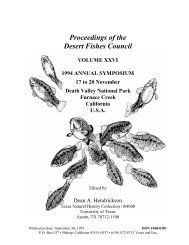
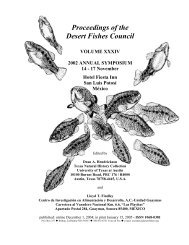
![Part 2 [419KK] - Desert Fishes Council](https://img.yumpu.com/14712282/1/190x245/part-2-419kk-desert-fishes-council.jpg?quality=85)

